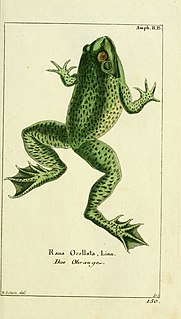This page is based on this
Wikipedia article Text is available under the
CC BY-SA 4.0 license; additional terms may apply.
Images, videos and audio are available under their respective licenses.

The Jamaican laughing frog is a species of frog in the family Hylidae. It is endemic to Jamaica. Other common names include Savanna-la-Mar treefrog.

The Jamaican snoring frog or Harlan's Antilles frog is a species of frog in the family Hylidae endemic to central Jamaica.
Its natural habitats are mesic broadleaf woods and forests with large dead trees. It can be found on tree trunks and in bromeliads; males call from hollows in branches and bromeliads. Eggs are laid in bromeliads. It is threatened by habitat loss.

The Hispaniolan common tree frog or Dominican tree frog is a species of frog in the family Hylidae endemic to the island of Hispaniola. It is found in the Dominican Republic and Haiti.
The yellow bromeliad frog or Spaldings tree frog is a species of frog in the family Hylidae endemic to central Jamaica. Its natural habitats are old-growth pine and deciduous forests where it is found in bromeliads. Eggs are also laid in bromeliads. It is threatened by habitat loss (deforestation).
The Hispaniolan yellow tree frog or common treefrog is a species of frog in the family Hylidae endemic to Hispaniola, where it is found in both the Dominican Republic and Haiti. Its natural habitats are mesic broadleaf forests, riparian forests, mangrove forests, grasslands, and marshes. It can also be found in agricultural landscapes. Males call in flooded pools after heavy rains.
The Hispaniolan giant tree frog or Hispaniola tree frog is a species of frog in the family Hylidae endemic to Hispaniola and found in both the Dominican Republic and Haiti. It is patchily distributed in across the island. Populations from the southern part of Hispaniola may represent a separate, as yet undescribed species.
Eleutherodactylus auriculatoides is a species of frog in the Eleutherodactylidae family endemic to the Cordillera Central in the Dominican Republic. Its natural habitats are montane closed forest. It is an arboreal species often found in bromeliads. Habitat loss caused by agriculture and charcoal production is the main threat to it.
The khaki bromeliad frog or Fowler's robber frog is a species of frog in the Eleutherodactylidae family endemic to Hispaniola. It occurs in the Massif de la Selle and is known from one site in the Dominican Republic and one in Haiti. It is named after Danny C. Fowler, collector of the holotype.
The La Selle red-legged frog or Furcy robber frog is a species of frog in the Eleutherodactylidae family. It is endemic to southern Hispaniola and occurs in both Haiti and the Dominican Republic. Specifically, it occurs on the Massif de la Selle (Haiti) to the western Baoruco Mountain Range. Its natural habitats are upland mesic pine forests, where it is usually found under rocks and logs. It is threatened by habitat loss caused by logging and agriculture. It is known from protected areas, but habitat loss continues also within those areas.
The half-stripe bromeliad frog or Shreve's robber frog is a species of frog in the Eleutherodactylidae family endemic to Hispaniola and found in both the Dominican Republic and Haiti. Its natural habitats are subtropical or tropical moist lowland forests and subtropical or tropical moist montane forests.
It is threatened by habitat loss.
Eleutherodactylus inoptatus is a species of frog in the Eleutherodactylidae family endemic to Hispaniola; it is found both in Haiti and the Dominican Republic. With female snout–vent length of about 88 mm (3.5 in), it is the largest eleutherodactylid frog.
The Hispaniolan yellow-mottled frog or painted robber frog, Eleutherodactylus pictissimus, is a species of frog in the Eleutherodactylidae family endemic to Hispaniola and found in both the Dominican Republic and Haiti. Its natural habitats are dry scrub forests, mesic broadleaf forests, and secondary forests. It is a terrestrial frog that lays its eggs on the ground. It is threatened by habitat loss.

Eleutherodactylus weinlandi is a species of frog in the Eleutherodactylidae family endemic to eastern Hispaniola; it is found in the Dominican Republic and central Haiti. It is a common, terrestrial frog that occurs in a range of mesic habitats: plantations, woods, gardens, ravines, and even trash piles in urban areas.
Eleutherodactylus wetmorei is a species of frog in the Eleutherodactylidae family. It is endemic to Hispaniola and occurs in both the Dominican Republic and Haiti. Specifically, it occurs on the Tiburon Peninsula (Haiti) and east to the Massif de la Selle in the southwestern Dominican Republic, and on the Massif du Nord in north-central Haiti east to west-central Dominican Republic. Its natural habitats are mesic broadleaf forests. It is an arboreal species occurring bromeliads and other plants, and also in leaf axils of bananas plantations. Eggs are laid in bromeliads. It is threatened by habitat loss caused by logging and agriculture. It is known from several protected areas, but most of them are in need of better management.
The common tree frog is a species in the shrub frog family, Rhacophoridae.
The giant tree frog, a frog in the family Hylidae and world's largest tree frog, is native to the rainforests of Northern Queensland, New Guinea, the Bismarck Islands, and the Admiralty Islands.



